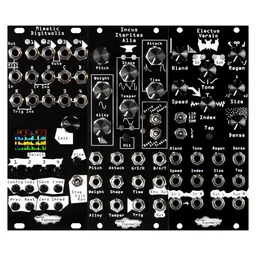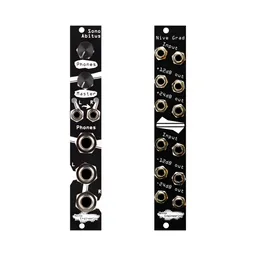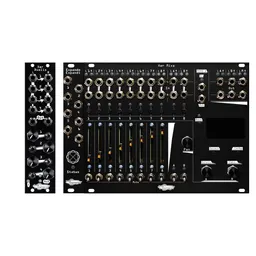I talk to a lot of musicians who are interested in modular synthesis, modular curious, or (especially at NAMM) just wonder what the *%#& this stuff is. Some seem intimidated by it, or just don’t know where or how to start. While there are a lot of introductory modular tutorials out there, few I’ve found are written to really help musicians capitalize on the strength of the knowledge they already have.
Today we start a series on modular synthesis using concepts and techniques that you, the musician, already know. We will focus on concepts to wrap your brain around, not specific modules (but hey, if that’s what you’re looking for, we can help!). Watch for future posts to help you understand building your first patch, selecting modules, buying and assembling your first case, and all sorts of other goodies for the person new to modular synthesis.
A quick note on learning modular: I’ve had more than one person approach me (generally aggressively) telling me to “teach” them how to play a modular synth (ok, this is usually at NAMM). The reality is that this is still a normal synthesizer, it’s just presented differently. Like any instrument, it will take time to play well. Most people don’t pick up a violin and master it in 20 minutes. Most people don’t master a traditional synthesizer in 20 minutes. A modular synth is no different. Be patient and give yourself the space to learn.

A modular synthesizer is just a “normal” synthesizer that’s been exploded.
So, how do modular synths differ from prebuilt synths, exactly? And more importantly, how are they the same?
Think about the standard Yamaha, Nord, or whatever keyed (or “fixed-architecture” if you’re fancy) synth you last bought or drooled over. In a traditional synth, it comes with a lot of things built in. Everything is prewired “under the hood.” You press buttons and turn knob, to sort through the premade sounds or to tweak the parameters they have built in for you to tweak. These can run the gamut of really basic to incredibly feature rich, but you don’t really get to change the basic architecture of the product. It’s fixed.
A modular synth is, well, modular. Instead of an off-the-shelf solution, you choose the components that will allow you to create the sound you desire. Each component module has some circuitry hardwired, but each module does only one or a few things, so you’re choosing it specifically for that function (like a filter or a distortion, etc.). You can easily change components in a modular system, too: If you don’t like the filter you’re using, swap it out for another one. Traditional synths aren’t built for that! In a modular system, you get to build it, not the engineers at [BIG INDUSTRIAL SYNTH COMPANY]. You choose your parts and then you make the connections using patch cables. You still make patches, but here they are physical, tangible things.
And of course there are SO MANY choices….choices are part of the joy, but also what makes modular systems somewhat daunting. There are hundreds of manufacturers, and in general, their modules all work perfectly fine together. Build a rack with modules from a single manufacturer, modules from all different manufacturers, or anything in between. The world is your oyster with modular synths.

There are several key differences between a fixed-architecture synthesizer and a modular synth.
-
Most traditional synths have a keyboard. Most modular synths do not.
In the modular world, that’s not a given. Sure, you can find a keyboard module or interface with an external keyboard. But pitch sequencing (most easily done by playing the keys on a traditional synth) is typically very sequencer or DAW oriented. That’s great news for those of you who never mastered those piano lessons, less good for the piano proteges out there.
-
A fixed-architecture synth makes sound when you hit a key. A modular synth always makes sound.
What? Let’s break this down. Both types of synths have a primary sound source (an oscillator). A keyed synth makes sound when you hit the key and then (generally) stops when you stop pressing the key. A modular synthesizer, on the other hand, has no keyboard, so we need to invert our thinking a bit. Modular oscillators just...oscillate. This means that rather than “telling” the instrument to make sound, you have to “tell” it to not make sound, typically with more modules. We’ll flesh out the details on how to control our oscillators in a future post when we start talking about patching, but for now, the takeaway is that when you put together a modular system, you get to design the way you want to sculpt your sound, in a way that you don’t get with a traditional synth.
-
Since a fixed-architecture synth is fixed, the sounds it can make are constrained by the architecture.
Again, firmware updates and tweaks to existing patches can expand on the capabilities of digital synths, but you’ve largely got what you’ve got. This is not a bad thing! There are some incredible synths out there and there’s a lot to be said for this ease of use.
In contrast, with modular synths, you build the connections every time you use it, which means you essentially have a brand new synth each time you patch. You can change patches or even modules at will. Tired of the sound of one oscillator? Yank it out and replace it with another! Tired of this sequencer? Drop a different one in. Components and patchpoints are infinite.
-
A traditional synth is ready to make sound when you buy it.
Plug it in, bang on the keys, and you’re making sound (ok, you’ll need to connect it to an amp, monitor, DAW, or something in most cases). Modular synths require you to do a bit more work: you’ll probably need a case, more than one module most likely, cables, power…(we’ll have more on all of these in future posts too!). The buy-in can be substantial, but you can also start small, and dip your toes in!

I have a case. Now what?
You already went out and bought everything? That was fast! Now we patch.
Okay, okay. We’ll cover Musician’s First Patch in a future post, but here, let’s just get some patch anxiety out of the way.
Signals flow between components through patch cables, including your audio, your control voltages, clock, anything. You decide where it goes, and you can shape your sounds in literally almost infinite ways. When I hand people patch cables for the first time, they either dive right in or freeze like a deer in headlights. If you are one of the latter, there are three things I want you to keep in mind.
-
You won’t break it by patching modules together.
I encouraged my teenage nephews who had never seen modules before to have at it, and the system came out unscathed. Also, it’s an incredible way to learn! The worst thing that can happen is that you get no sound or a sound you don’t like. Ok, unplug, and plug in somewhere else. That wasn’t so bad, was it?
-
Patching isn’t that different from routing modulation to parameters on a traditional synthesizer.
The LFO envelope amount knobs on a subtractive synth? That knob lets you make a connection between the envelope and the filter, which you’d just do with a cable in modular. Many synth plugins also let you route modulation sources to a plethora of destinations: that’s almost exactly like patching a modular synth.
-
Plug shit in.
When I demo a modules to someone who has never patched, I show them a module and then tell them to plug shit in. Repeat after me: You won’t break it by patching modules together.
If you’re already a synth person, modular isn’t that different. If you’re a musician, you probably already know a lot of the terms, you’ll just have to think about them in a slightly different context. If you think modular might be a good fit for your workflow and have questions, drop us a line, we’re happy to help!






